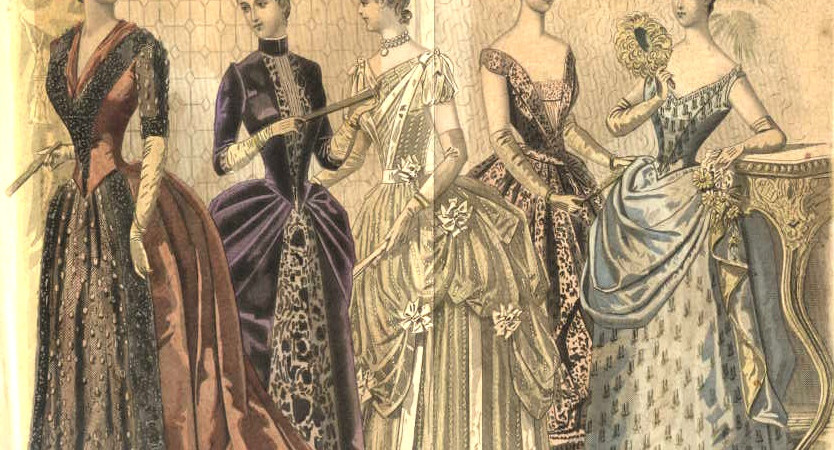The 63-year-old period from 1837 to 1901, under the reign of England’s Queen Victoria, saw sweeping changes ranging from political reforms to social changes. If you belonged to a well-off family during the Victorian Era, getting through a day with just one dress would be something unheard of. Strict etiquette was followed, regarding what attire should be worn to different events. This caused women to change their outfits several times during the day. We give you 11 interesting facts about 19th-century fashion among Victorian women.
1. Dress #1 was constricting yet “simple” as per 19th-century fashion experts
They would start their day with a relatively comfortable dress while meeting with their morning visitors and housekeepers. However, it’s important to remember that the dress seemed comfortable by Victorian standards, not ours. Although they had a simpler design, the dresses were constricting and structured.
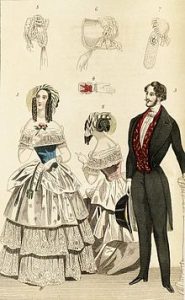
2. Dress #2 was strictly for strolls in the park
If a 19th-century Victorian woman felt like taking a stroll in the park, she would change into her walking dress. These were shorter and lacked a trail that would sometimes constrict movements. Passers admired the walking dresses as they were usually made out of rich fabrics.
3. Dress# 3 depicted 19th-century fashion for the afternoon
After returning home from their walk, they would change into dress three. Are you tired yet? This was an afternoon dress and was worn while receiving visitors or visiting other women. They had long trains and a deeper neckline. The formal afternoon dresses were reserved for higher visitors.

4. Last but not least, dress #4 was worn while dining in for dinner
Just when you thought they were done for the day, women would change into a dinner dress. Although the visitors would have left, these dresses were the most formal ones as 19th-century fashion demanded that. Its skirts would touch the ground and they were made of velvet, silk, or satin.
5. Victorian ball gowns were sometimes 65 inches long!
The evening dress or the Victorian ballgown was always the showstopper. They had short sleeves and long trains, sometimes almost 65 inches in length. The fabric depended on the women’s taste and how affluent they were. Trains of these dresses could be pinned up while dancing as well.
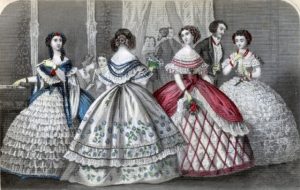
6. 19th-century fashion permitted mourning women to only wear black crepe
After the death of Prince Albert in 1981, Victorian society got very dull. Due to this, Queen Victoria set some standards for mourning fashion. The women were to follow strict rules about not only how they dressed but also how they interacted. If these rules were ignored, it was considered an insult to the dead. During the mourning of husbands, wives were to don only the black crepe. Rich looking silks and satins were not permitted and women would often carry cashmere and merinos. Jewellery wasn’t encouraged either.

7. Showing hands equalled showing cleavage for the Victorians
Gloves were a statement piece during the Victorian period among middle and upper-class women. It was more than an accessory and acted as a social necessity. During the time, women showing hands were not permitted and it was equal to a woman showing too much cleavage, according to 19th-century fashion.
Due to this rule, women possessed different types of gloves for every occasion. During the day, they wore short ones made of several fabrics, embroidery, and designs. For the evenings, their gloves were made of a black filet. But, white versions of those existed as well. Sometimes, they would be decorated with flowers, satin ribbons and even feathers.

8. The slogan for 19th-century fashion was “no pain, no gain”
The most extreme clothing pieces of the Victorian Era have to be the corsets. At the time, Victorian society idealised those with an hourglass figure and ladies would squeeze themselves into these corsets. They were unimaginably tight and most often crushed their internal organs. However, they believed that beauty required pain and didn’t mind suffering as long as they had a 16-inch waist.
Earlier, they were quite comfortable as they provided support. However, with the introduction of the industrial revolution, corsets became more sophisticated. Met eyelets were used in their finishing. Due to this, many women began to tight lace. They even took inspiration from the Empress Elisabeth of Austria, who attained a 16-inch waist by doing so.
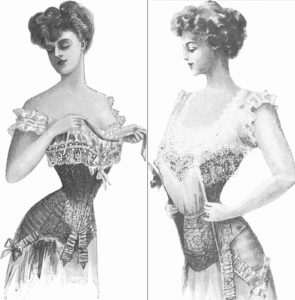
9. Who said cages were just for animals?
The 1850s saw women idolising hourglass figures more than ever, which made them follow some bizarre fashion. They resorting to shaping their bodies with the help of a crinoline cage.
It was initially a petticoat made out of horsehair and held the skirt out from the body. However, with the growing obsession over the wideness of skirts during the industrial revolution, wired crinoline cages were used as a solution.
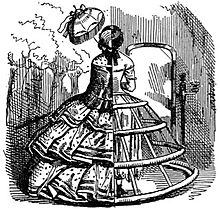
10. The late Victorian Era saw flatter skirts
Although women’s fashion underwent drastic changes during the industrial revolution and the victorian age, it was in the later years that 19th-century fashion saw some significant differences in the tone of Victorian dressing. The late Victorian era saw many changes from all sectors – fashion, style of clothing, social structure, etc.
By the 1860s, women donned flatter skirts rather than the bell-shaped, flared ones that their ancestors preferred. The dresses worn during the day possessed pagoda sleeves and a higher neckline. Some necklines had lace or a tatted collar on them as well.
They opted for lower necklines for evening wear and shorter sleeves with gloves. In 1870, tea gowns were worn for casual get-togethers at their homes.
11. Finally, they began to dress simpler and more comfortably
By 1887, sleeves were less puffy, slimmer and close fitted. Dresses during the 1880s were mostly made in colours like deep red, royal blue, purple and peacock blue. These colours were used alone or combined or even used in tartan fabrics. As they approached the 1890s, women dressed much simpler than they did earlier.
They no longer used painful crinoline cages and bustles and instead wore looser outfits. Corsets were made not to choke but to give a slight S shape to the woman’s body. Skirts flared above the knees and were close-fitted on the hips. Late Victorian women made use of high necks and puffed sleeves. They also donned sportswear like tennis dresses and bicycle dresses.

